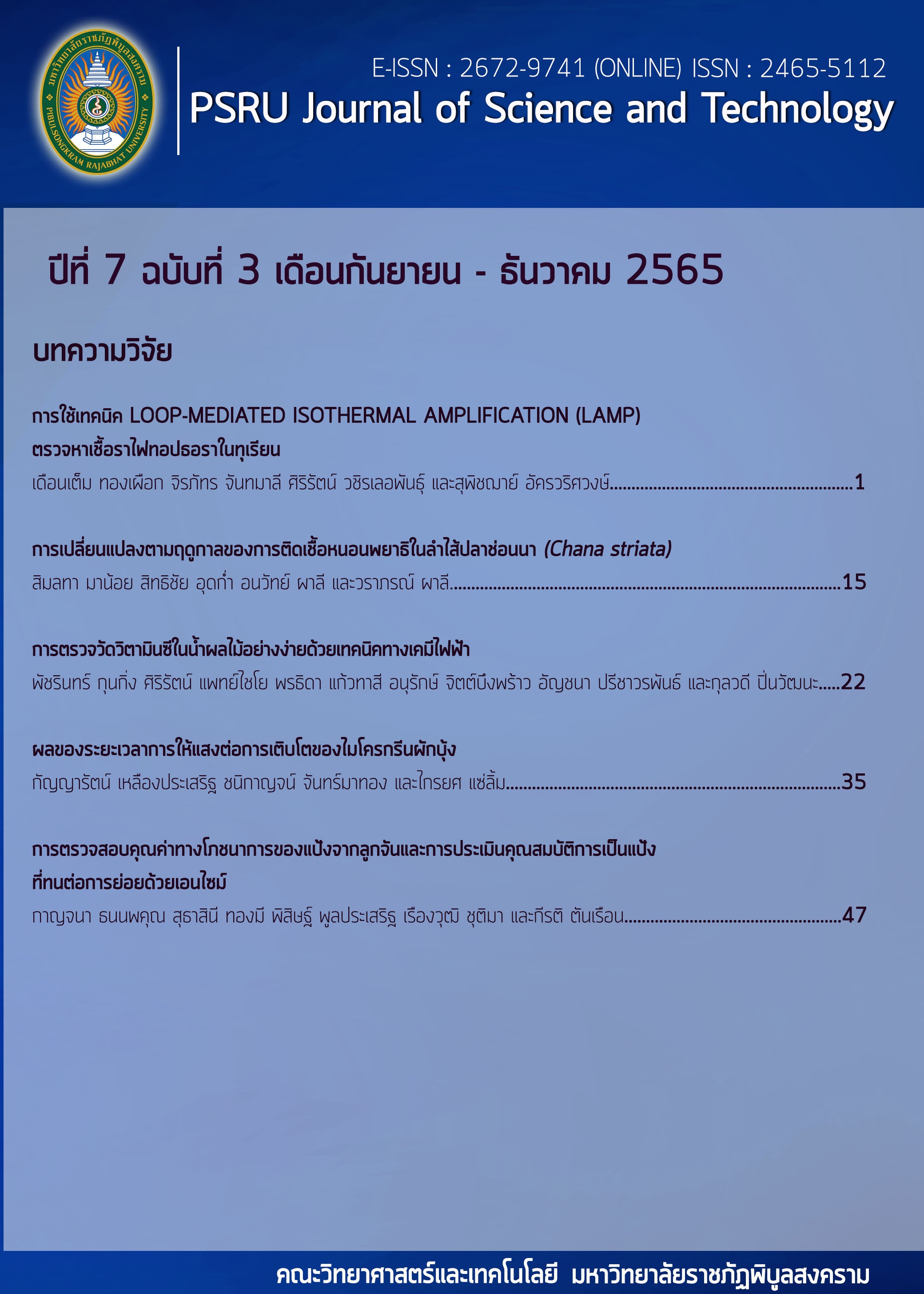DETERMINATION OF NUTRITIONAL VALUE FROM GOLD APPLE (Diospyros decandra Lour.) FLOUR AND EVALUATION OF RESISTANT STARCH
Keywords:
Flour, Starch, Gold Apple, Nutritional valueAbstract
The objectives of this study were to produce the gold apple (Diospyros decandra Lour.) flour and to determine the nutritional values. The flour production from gold apple raw fruits were prepared using three different methods including dry, wet and semi-dry millings. The result showed that dry milling process exhibited the highest production yield of 13.04% (P<0.05), followed by semi-dry and wet milling processes of 10.80 and 3.24%, respectively. In the proximate analysis of dry milled flour, the contents of carbohydrate, moisture, protein, ash and lipid were 80.43, 7.44, 6.19, 3.52, and 0.42 g/100 g, respectively. Herein, the crude fiber was found of 7.94 g/100 g. The resistant starch content was also found to be 30.37% dry weight. Additionally, the energy 334.26 Kcal/100 g, calcium (40.71 mg/100 g), sodium 6.72 mg/100 g), iron (1.44 mg/100 g) and vitamin A (6.34 µg/100 g) were also detected. The results from this study are likely to be applied for further development and high value-adding gold apple flour in various industries.
References
กีรติ ตันเรือน. (2562). การประเมินองค์ประกอบทางเคมีและฤทธิ์ทางชีวภาพของสารสกัดจากลูกจัน ภายใต้โครงการอนุรักษ์พันธุกรรมพืชอันเนื่องมาจากพระราชดำริฯ มหาวิทยาลัยราชภัฏพิบูลสงคราม พ.ศ. 2562 (รายงานวิจัยฉบับสมบูรณ์). พิษณุโลก: มหาวิทยาลัยราชภัฏพิบูลสงคราม.
เกวลี พร้อมพิพัฒนพร. (2557). ผลของการดัดแปรพื้นผิวเม็ดสตาร์ชมันสำปะหลังต่อการเกิดเดกซ์ทรินต้านทานการย่อย (รายงานการวิจัยฉบับเต็ม). นครราชสีมา: มหาวิทยาลัยเทคโนโลยีสุรนารี.
จิรนาถ บุญคง, ทิพวรรณ บุญมี, และพัชราวรรณ เรือนแก้ว. (2558). การใช้แป้งกล้วยหอมทองดิบที่มีสมบัติต้านทานการย่อยสลายด้วยเอนไซม์ในผลิตภัณฑ์พาสต้า. วารสารเทคโนโลยีการอาหาร มหาวิทยาลัยสยาม, 10(1), 21-27.
ประกานต์ ฤดีกุลธำรง, และจารุณี ควรพิบูลย์. (2555). พรีไบโอติก: อาหารส่งเสริมสุขภาพ. ธรรมศาสตร์เวชสาร, 17(2), 362-369.
ปาริฉัตร พฤกษ์วิวัฒนากุล. (2556). การผลิตสตาร์ชที่ทนต่อการย่อยด้วยเอนไซม์จากสตาร์ชชนิดต่างๆ และการตรวจสอบคุณสมบัติพรีไบโอติก. สงขลา: มหาวิทยาลัยสงขลานครินทร์.
มาศอุบล ทองงาม. (2551). อิทธิพลของสภาวะต่างๆ ในกระบวนการผลิตต่อสมบัติของแป้งและสตาร์ชข้าวฟ่าง. (รายงานวิจัย). กรุงเทพฯ: มหาวิทยาลัยเกษตรศาสตร์.
เยาวพา กลิ่นกุหลาบ, และกาญจนา ธนนพคุณ. (2562). การสำรวจและศึกษาสัณฐานวิทยาของต้นจัน (Diospyros decandra Lour.) ในเขตอำเภอเมือง จังหวัดพิษณุโลก. ใน การประชุมวิชาการระดับชาติพิบูลสงครามวิจัย ครั้งที่ 4. (น.134-141). พิษณุโลก: มหาวิทยาลัยราชภัฏพิบูลสงคราม.
รัชนีพร โพธินาม, อนุชิตา มุ่งงาม, และทัตดาว ภาษีผล. (2559). องค์ประกอบทางเคมีและคุณสมบัติทางกายภาพของสตาร์ชจากถั่วเขียวและถั่วพุ่มและการประยุกต์ใช้ในการผลิตวุ้นเส้น. แก่นเกษตร, 44, 1073-1079.
วิจิตรา เหลียวตระกูล, และวชิรญา เหลียวตระกูล. (2563). ผลของวิธีการโม่ต่อสมบัติทางเคมีกายภาพ ความหนืดและการแยกตัวของน้ำของแป้งกระจับ (Trapa bispinosa). ว.วิทยาศาสตร์และเทคโนโลยี, 9(2), 251-264.
ศศิธร แท่นทอง, อัคกะบัทคาน ปาทาน, นัทรักษ์ รอดเกตุ, วิลาสินี ดีปัญญา และรุจิรา คุ้มทรัพย์. (2564). ผลของกรรมวิธีการหุงต่อปริมาณแป้งต้านทานการย่อยในข้าวพันธุ์พื้นเมืองที่ปลูกในจังหวัดเพชรบูรณ์. PSRU Journal of Science and Technology, 6(3), 135-146.
ศันสนีย์ อุดมระติ, พัชรี ตั้งตระกูล, และงามจิตร โล่วิทูร. (2562). ผลของวิธีการโม่ต่อสมบัติทางเคมีฟิสิกส์ของแป้งข้าวขาวดอกมะลิ 105 และการนำไปประยุกต์ใช้ในผลิตภัณฑ์ปลอดกลูเตน. ว.วิทยาศาสตร์และเทคโนโลยี, 27(2), 311-325.
สุนันทา ทองทา. (2552). คุณสมบัติแป้งข้าวที่ทนต่อการย่อยด้วยเอนไซม์จากข้าวพันธุ์ต่างๆ เพื่อใช้ในอาหารเพื่อสุขภาพ (รายงานการวิจัยฉบับเต็ม). นครราชสีมา: มหาวิทยาลัยเทคโนโลยีสุรนารี.
AOAC. (2000). Offcial Methods of Analysis. (16th ED). Association of Official Analytical Chemist.
Asmeda, R., Noorlaila, A., & Norziah, M.H. (2015). Effects of different grinding methods on chemical and functional properties of MR211rice flour, Int. J. Food Eng., 1, 111-114.
Bunluepuech, K., & Tewtrakul, S. (2009). Anti-HIV-1 integrase activity of Thai medicinal plants. Songklanakarin. Journal of Science and Technology, 31, 289-292.
IBM, Corp. (2015). IBM SPSS Statistics for Windows, Version 23.0. Armonk, NY: IBM Corp.
Li, H., Jiao, A., Wei, B., Wang, Y., Wu, C., Jin, Z., & Tian, Y. (2013). Porous starch extracted from Chinese rice wine vinasse: Characterization and adsorption properties. International Journal of Biological Macromolecules, 61, 156-159.
McCleary, B.V., & Monaghan, D.A. (2002). Measurement of resistant starch. J. AOAC. international, 85, 665-675.
Nugent, A.P. (2005). Health properties of resistant starch. Nutrition Bulletin, 30, 27–54.
Prasad, K., Singh, Y., & Anil, A. (2012). Effects of grinding methods on the characteristics of Pusa 1121rice flour. J. Trop. Agric. FoodSci, 40, 193-201.
Qiang, X., YongLie, C., & QianBing, W. (2009).Health benefit application of functional oligosaccharides. Carbohydr. Polym, 77, 435-441.
Singh, J., Kaur, L., & McCarthy, O.J. (2007). Factors influencing the physico-chemical morphological, thermal and rheological properties of some chemically modified starches for food applications-A review. Food Hydrocolloids, 21, 1-22.
Siró, I., Kápolna, E., Kápolna, B., & Lugasi, A. (2008). Functional food. Product development, marketing and consumer acceptance - A review. J. Appetite, 51, 456-467.
Vatanasuchart, N., Niyomwit, B., & Wongkrajang, K. (2009). Resistant starch contents and the in vitro starch digestibility of Thai starchy foods. Kasetsart J. (Nat. Sci.), 43, 178-186.
Downloads
Published
How to Cite
Issue
Section
License
Copyright (c) 2022 PSRU Journal of Science and Technology

This work is licensed under a Creative Commons Attribution-NonCommercial-NoDerivatives 4.0 International License.
กองบรรณาธิการขอสงวนสิทธิ์ในการปรับปรุงแก้ไขตัวอักษรและคำสะกดต่างๆ ที่ไม่ถูกต้อง และต้นฉบับที่ได้รับการตีพิมพ์ในวารสาร PSRU Journal of Science and Technology ถือเป็นกรรมสิทธิ์ของคณะวิทยาศาสตร์และเทคโนโลยี มหาวิทยาลัยราชภัฏพิบูลสงคราม และ
ผลการพิจารณาคัดเลือกบทความตีพิมพ์ในวารสารให้ถือมติของกองบรรณาธิการเป็นที่สิ้นสุด







